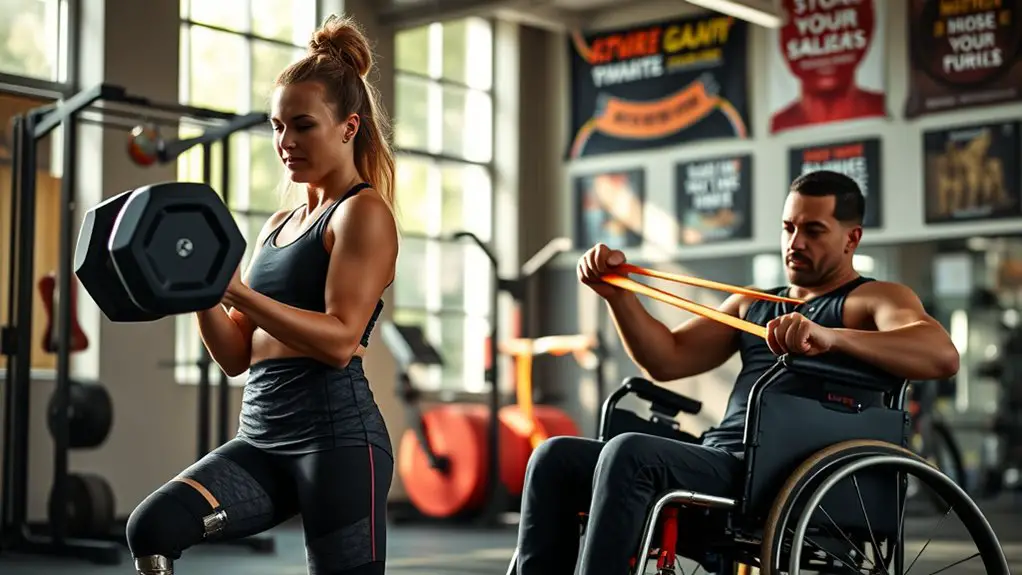Strength training's essential for hockey players like you, boosting power, speed, and stability on the ice. Focus on core stability exercises like planks and Russian twists, alongside lower body strengthening with squats and deadlifts. Don't forget upper body workouts, including push-ups and rows, plus explosive plyometric drills like box jumps. Resistance bands are great, too—try banded squats and lateral walks. Want to learn about conditioning and recovery methods? There's more to enhance your game.
Importance of Strength Training in Hockey
When it comes to hockey, strength training isn't just a nice addition; it's vital for your performance on the ice. You want to release your full potential, and that starts with building a solid foundation. Strength training benefits you by enhancing your power, speed, and agility, allowing you to outpace your opponents and dominate the game. Additionally, focusing on essential muscle groups can significantly improve your overall athletic performance. But it's not just about performance; it's also about staying in the game. Effective injury prevention strategies are essential, and strength training plays a key role in this. By targeting specific muscle groups, you can improve your stability and resilience, reducing the risk of injuries that could sideline you.
Core Stability Exercises
Building strength in your legs and upper body is important, but don't overlook the power of a strong core. Core strength is essential for hockey players, as it enhances your balance, stability, and overall performance on the ice. When you engage in stability training, you're not just building muscle; you're creating a solid foundation that allows for freedom of movement.
Exercises like planks, Russian twists, and stability ball rollouts challenge your core and improve your ability to maintain control during quick maneuvers. A strong core also helps prevent injuries, giving you the confidence to push your limits without fear of setbacks. Additionally, developing core strength improves movement efficiency, allowing you to perform at your best during intense games.
Incorporate these exercises into your routine, and you'll notice how much more agile and powerful you feel during games. Embrace the freedom that comes with a strong core, and watch your performance soar as you dominate on the ice.
Lower Body Strengthening
Lower body strengthening is fundamental for hockey players, as powerful legs contribute to explosive speed, stability, and overall on-ice performance. To release your full potential, you should focus on squat variations and deadlift techniques. Squats, whether they're back squats or front squats, build strength in your quads and glutes, essential for those hard strides on the ice. Incorporating single-leg squats can enhance balance and target stabilizing muscles, giving you that extra edge. Deadlifts, on the other hand, engage multiple muscle groups, including your hamstrings and lower back. Mastering conventional and sumo deadlift techniques helps develop the posterior chain, which is important for acceleration and power. Additionally, incorporating Olympic lifts can further improve your explosive strength and overall athletic performance.
Upper Body Strengthening
While strong legs are essential, upper body strengthening is equally important for hockey players, as it enhances shooting power, puck control, and overall stability during play. Focusing on exercises that improve upper body mobility and shoulder stability will help you perform at your best on the ice.
Incorporate movements like push-ups, bench presses, and rows into your routine. These exercises not only build strength but also promote better range of motion, allowing for smoother, more powerful shots. Don't forget to include shoulder-specific exercises, such as external rotations and shoulder presses, to guarantee your joints stay stable during intense gameplay.
Adding resistance bands can be a game-changer, too. They help improve your upper body mobility while engaging multiple muscle groups. By committing to upper body strengthening, you'll not only enhance your overall performance but also release your full potential as a hockey player. Additionally, focusing on compound movements can maximize your strength gains and enhance overall athletic performance.
Plyometric Drills for Explosiveness
To excel on the ice, incorporating plyometric drills into your training routine is essential for developing explosiveness. Jump training, like box jumps or depth jumps, can greatly enhance your explosive power, allowing you to accelerate faster and improve your shot strength. These drills help your muscles learn to exert maximum force in minimal time, a vital skill for any hockey player.
Additionally, plyometrics focus on improving nervous system efficiency, which can lead to faster muscle response and better overall performance on the ice. Start with basic movements, focusing on your technique before adding intensity. Once you're comfortable, you can progress to more complex exercises, like single-leg hops or lateral jumps, which engage stabilizer muscles and improve your overall athleticism.
Aim for a mix of high-rep and low-rep sets, striking the right balance between volume and intensity. Remember, the goal is to harness that explosive energy, so stay focused and push your limits. With consistent plyometric training, you'll find yourself dominating the ice and leaving your opponents in the dust.
Agility and Balance Training
Agility and balance are essential for your performance on the ice, helping you react quickly and maintain control during games. Incorporating specific drills into your training can enhance these skills, giving you an edge over your opponents. Let's explore how focusing on agility and balance can elevate your overall game. Additionally, strength training plays a crucial role in developing the muscle power necessary for effective agility and balance on the ice.
Importance of Agility Training
Understanding the importance of agility training is essential for hockey players looking to enhance their on-ice performance. Agility isn't just about speed; it's about how quickly you can change direction while maintaining control. Incorporating agility drills into your routine boosts your reaction time, helping you evade opponents and seize scoring opportunities. Coordination exercises complement these drills, improving your body awareness and balance. When you combine these elements, you'll notice a significant difference in your gameplay. You'll become more fluid and responsive, allowing for those game-changing plays. Remember, agility training is a game-changer that contributes to your overall athleticism, giving you the freedom to express your skills on the ice. Embrace it, and watch your performance soar!
Balance Drills for Performance
Improving your balance is just as important as honing your agility when it comes to enhancing on-ice performance. Mastering balance training techniques can set you free on the rink, allowing for effortless maneuvers and quick responses. Incorporate dynamic balance exercises into your routine, like single-leg stands or stability ball workouts, to boost your core stability and coordination. These drills challenge your body's ability to adapt, equipping you to handle the unpredictable nature of hockey. Try using a balance board or performing lateral hops to engage your muscles in new ways. By prioritizing these exercises, you'll not only elevate your balance but also enhance your overall game, making you a formidable player on the ice.
Resistance Band Workouts
Resistance band workouts are a fantastic addition to your training routine, offering benefits like improved strength and flexibility without heavy weights. You can easily incorporate key exercises that target essential muscle groups for hockey performance. Let's explore how these bands can enhance your strength training and keep you on the ice longer. Moreover, their portability and convenience allow you to maintain a consistent training regimen anywhere, ensuring you stay in peak condition.
Benefits of Resistance Bands
When it comes to enhancing strength and performance on the ice, incorporating resistance bands into your training routine can be a game changer. Their resistance band versatility allows you to target specific muscle groups and adjust intensity easily, letting you train effectively no matter where you are. Plus, these bands are lightweight and portable, giving you the freedom to work out anywhere. One of the standout benefits is their injury prevention benefits, as they promote proper form and muscle activation, reducing the risk of strains and tears. By integrating resistance bands, you'll not only boost your power and stability but also protect your body from injuries, ensuring you stay on the ice and perform at your best.
Key Resistance Band Exercises
Incorporating a few key resistance band exercises into your training can greatly enhance your strength and agility on the ice. These band exercises offer unique resistance benefits that help you build functional strength while improving your stability and control. Plus, they're easy to integrate into any workout routine, allowing you the freedom to train anywhere.
Here are five effective resistance band exercises to try:
- Banded Squats: Engage your lower body and core.
- Lateral Band Walks: Boost your hip strength and lateral movement.
- Seated Rows: Strengthen your upper back and improve posture.
- Chest Press: Build power for shooting and passing.
- Shoulder External Rotations: Enhance shoulder stability and reduce injury risk.
Embrace these exercises for a competitive edge on the ice!
Sport-Specific Conditioning
Sport-specific conditioning is essential for hockey players, as it enhances performance by mimicking the demands of the game. You want to focus on incorporating sport-specific drills into your training, which will help build the stamina and strength needed on the ice. These drills often replicate the intensity and movement patterns you encounter during a match, so they're vital for developing your on-ice skills.
Consider integrating conditioning routines that emphasize short bursts of energy combined with recovery periods, just like during a game. Activities like shuttle runs, interval sprints, and agility drills can improve your explosiveness and speed. Additionally, plyometric exercises can help you develop the power needed for quick skating and explosive movements. Incorporating high-intensity interval training into your regimen can further enhance your overall conditioning and mental toughness.
Recovery and Injury Prevention
When it comes to hockey, recovery and injury prevention are just as essential as strength training. You'll want to focus on improving flexibility, strengthening your core stability, and mastering effective warm-up techniques. These elements can help keep you on the ice and performing at your best. Additionally, incorporating mobility training into your routine will enhance your range of motion and reduce the risk of injuries.
Importance of Flexibility
While many players focus on strength and conditioning, neglecting flexibility can lead to missed opportunities for recovery and injury prevention. Incorporating flexibility routines into your training is essential for maintaining your freedom of movement on the ice. Dynamic stretching, in particular, prepares your muscles and joints for the demands of hockey, helping to enhance performance.
Consider these benefits of flexibility:
- Reduces muscle tension
- Improves range of motion
- Enhances overall performance
- Minimizes risk of injury
- Aids in faster recovery
Strengthening Core Stability
Strengthening your core stability is essential for recovery and injury prevention, as a strong core supports your entire body during the dynamic movements of hockey. By focusing on core strength, you'll enhance your overall performance and reduce the risk of injuries. Stability training can include exercises like planks, Russian twists, and medicine ball throws, which engage your abdominal muscles and improve balance. Incorporating these exercises into your routine not only stabilizes your spine but also boosts your power and agility on the ice. Remember, a solid core acts as the foundation for all your movements, enabling you to skate faster and hit harder. Prioritize core stability, and you'll find more freedom in your game while minimizing the chances of getting sidelined by injury.
Effective Warm-Up Techniques
A proper warm-up is essential for preparing your body for the demands of hockey, as it not only enhances performance but also plays an important role in injury prevention. Incorporating dynamic stretches and mobility drills into your routine can help you get ready to hit the ice. Here are some effective techniques to evaluate:
- Arm circles to loosen shoulders
- Leg swings to improve hip mobility
- Walking lunges for lower body activation
- High knees to increase heart rate
- Torso twists for core engagement
Creating a Balanced Training Program
To create a balanced training program for hockey players, it is essential to integrate various components that enhance both strength and endurance. Focus on periodization strategies to guarantee you're varying your training intensity and volume over time. This approach allows your body to adapt and recover, ultimately improving performance on the ice.
Incorporating a mix of strength training, cardio, and skill work will keep your workouts engaging and effective. Aim for a training frequency that suits your schedule—typically three to five days a week—while allowing for adequate rest to prevent burnout.
Don't forget to listen to your body; if you're feeling fatigued, adjust your program accordingly. By prioritizing a balanced approach, you'll not only build the strength needed for hockey but also maintain the endurance to last through those intense games. Embrace the journey, and enjoy the freedom that comes with being a well-rounded athlete!
Frequently Asked Questions
How Often Should Hockey Players Strength Train Each Week?
When considering how often you should strength train each week, it's crucial to find a balance that fits your lifestyle. Aiming for about 2 to 3 sessions can optimize your strength training frequency while allowing time for recovery. A well-structured weekly workout schedule should leave you feeling energized rather than fatigued. Remember, it's about enhancing your performance and enjoying your training, so listen to your body and adjust as needed.
What Is the Ideal Duration for a Strength Training Session?
You might think longer sessions mean better results, but that's not always true. For effective strength training, aim for a session length of 45 to 60 minutes. This workout structure allows you to maximize your efforts without burning out. Keeping it focused helps maintain intensity and motivation, letting you enjoy the freedom of a well-rounded routine. Remember, quality trumps quantity when it comes to building strength efficiently.
Can Beginners Start Strength Training Without Prior Experience?
Absolutely, you can start strength training as a beginner without prior experience! It's all about focusing on beginner exercises that suit your fitness level. Just remember to prioritize training safety; using proper form and starting with lighter weights will help prevent injuries. As you gain confidence and strength, you can gradually progress. Embrace the journey, and don't hesitate to seek guidance if you need it—freedom in training comes from knowledge and practice!
Are There Any Specific Nutrition Tips for Strength Training?
When it comes to strength training, nutrition plays a vital role. You should focus on nutrient timing; eating the right foods around your workouts can maximize your gains. Make sure you're hitting your protein intake, aiming for about 1.6 to 2.2 grams per kilogram of body weight. This'll help your muscles recover and grow. Don't stress too much—just enjoy the process and find what works best for you!
How Do I Know if I Am Overtraining?
Did you know that 70% of athletes experience symptoms of overtraining at some point? If you're feeling chronic fatigue, irritability, or a drop in performance, it might be time to reassess your training. Listen to your body—if you're not recovering well, you might be pushing too hard. Incorporating recovery strategies like rest days, proper nutrition, and hydration can help you find that balance, allowing you to train effectively without sacrificing your freedom to perform.




